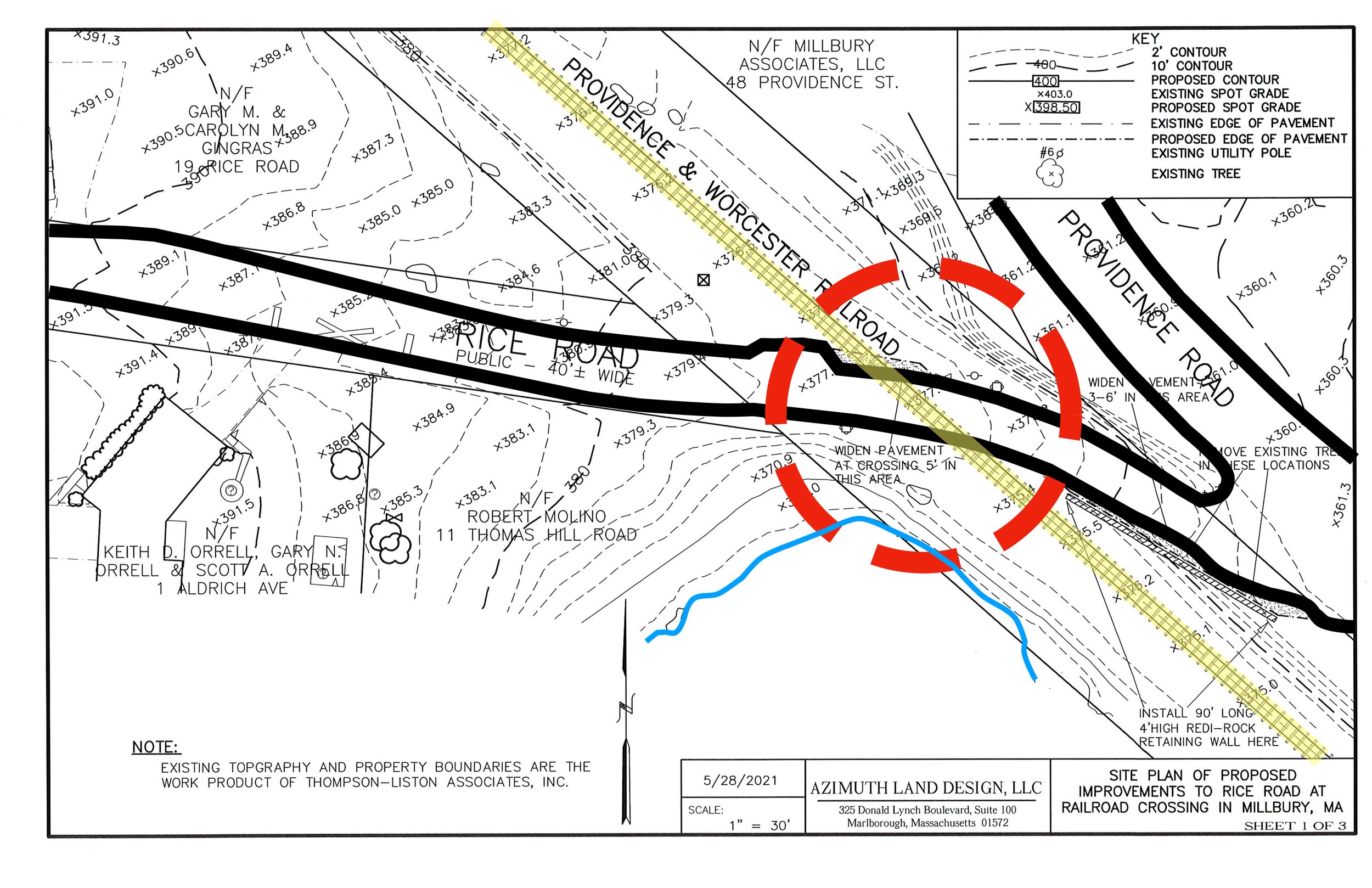Providence & Worcester Railroad Crossing Upgrades
Genesee & Wyoming Railroad Services, Inc., the parent company of the Providence & Worcester Railroad, has revised its plan and cost estimate for bringing the Rice Road railroad crossing into compliance with American Railway Engineering and Maintenance-of-Way Association (AREMA) standards, in response to the anticipated increase in traffic from the proposed Chapter 40B Rice Pond Village project.
Illustrates the current pavement and at-grade crossing of Providence & Worcester Railroad at Rice Road. Additionally, it displays the inadequate railroad crossing improvement proposal from the developer's project engineer, who has now abandoned any responsibility for the necessary enhancements, largely prompted by their development plans.
Genesee & Wyoming Railroad Services, Inc., along with the Providence & Worcester Railroad and our community, place a high priority on public safety. It's crucial for the town, state, and developer to do the same. Unfortunately, the developers have not placed public safety as a priority. They have urged the Millbury Planning Board and the neighborhood to overlook public safety concerns, seemingly in pursuit of their own development interests. This stance appears unchanged. Consequently, their initial project plans for 46 condominiums were denied by the Millbury Planning Board for this reason.
Their letter reads as follows:
The Providence and Worcester Railroad (P&W) has several concerns at Rice Road crossing involving public safety. Currently Rice Road meets all requirements for the existing conditions of the area. The following are the eight main considerations taken when determining the necessity to installing upgraded active warning devices:
Public and Employee safety
Volume of vehicular traffic
Volume of railroad traffic
Speed of vehicular traffic
Speed of railroad traffic
Volume of pedestrian traffic
Collision record
Sight distance restrictions
The only variable with this project is the addition housing units and the widening of Rice Road, which will significantly increase the volume of vehicular and pedestrian traffic along with vehicular speed at this crossing, causing the current warning assembly to be out of compliance. It is not the financial responsibility of the P&W to upgrade existing satisfactory railroad assets to align with increased standards necessary to support the modifications being made to the surrounding properties that do not directly involve the railroad.
— Genesee & Wyoming Railroad Services, Inc.
The crucial point to emphasize in their letter is that "The Providence & Worcester Railroad is not financially responsible for upgrading already satisfactory railroad assets to accommodate changes in surrounding properties that do not directly pertain to the railroad itself." The consensus among our neighborhood is that the burden should not be placed on the Providence & Worcester Railroad. Instead, it should rest with Steven Venincasa and James Venincasa, who are advocating for a significant rise in Annual Average Daily Traffic (AADT) along Rice Road and at the Providence & Worcester Railroad crossing near Providence Street (Route 122A). Steven Venincasa and James Venincasa have firmly stated their refusal to contribute to the improvement of local roads and infrastructure needed to handle the heightened demand resulting from their project. Instead, they anticipate that local and state taxpayers will foot the bill for these enhancements, even though they are mainly necessitated by their project plans. The estimated cost for the upgrades to the Rice Road railroad crossing is $432,659.42. The crossing is anticipated to be closed for at least four days, starting on a Friday morning and ending on the subsequent Monday afternoon.
It's crucial to recognize that the Providence & Worcester Railroad holds ownership of the land extending from the western side of the railroad crossing to Providence Street (Route 122A), encompassing that section of Rice Road. Any work within the railroad crossing or on their property requires prior authorization from the railroad. The Providence & Worcester Railroad holds a pivotal role in the proposed Chapter 40B Rice Pond Village project. Their approval and involvement are essential to prioritize public safety for both the community and railroad personnel in all design, decision-making, and approval processes.
According to the Federal Railroad Administration (FRA)'s 2023 Accident Prediction Report for Public At-Grade Highway-Rail Crossings, the Rice Road railroad crossing experiences an Average Annual Daily Traffic (AADT) of 470 vehicles, making it the third busiest railroad crossing in Millbury. South Main Street tops the list with 3,700 vehicles, followed by Curve Street with 520 vehicles. Despite this, Rice Road ranks second in terms of the highest collision prediction, closely trailing South Main Street. Notably, the Providence & Worcester Railroad has had no collisions in Millbury during the reporting period. Rice Road is unique as the only public at-grade railroad crossing without crossing gates; although, it previously had such gates, they were removed in 1979, with the reasoning behind this decision remaining undisclosed.
massDOT reported one motor vehicle accident at the railroad crossing, which did not involve any railroad assets or personnel.
A long-time resident of the neighborhood recalls a train derailment from their childhood days, which happened between Rice Road and Curve Street railroad crossings, adjacent the proposed project site. No such incident has occurred since. The drainage system at the eastern edge of Simpson's Pond experienced a failure, leading to erosion beneath the railroad tracks. This incident necessitated the closure of the tracks for repairs and adjustments. Residents living near Simpson's Pond reported seeing fish scattered along Providence Street, with some motorists trying to collect them and release them into the Blackstone River located on the street's eastern side.
Annual Average Daily Traffic (AADT) estimates, with as little bias as possible, the mean traffic volume across all days for a year for a given location along a roadway. AADT is a basic measurement that indicates vehicle traffic load on a road segment. It measures how busy a road is and is a critical input parameter in many transportation planning applications as well as for fund allocation to transportation agencies.

